Civil defense siren
A civil defense siren (also known as an air-raid siren) is a siren used to provide an emergency population warning to the general population of approaching danger. It is sometimes sounded again to indicate the danger has passed. Some sirens (especially within small towns) are also used to call the volunteer fire department when needed. Initially designed to warn city dwellers of air raids in World War II, they were later used to warn of nuclear attack and natural destructive weather patterns such as tornadoes. The generalized nature of sirens led to many of them being replaced with more specific warnings, such as the broadcast-based Emergency Alert System and the Cell Broadcast-based Wireless Emergency Alerts and EU-Alert mobile technologies.
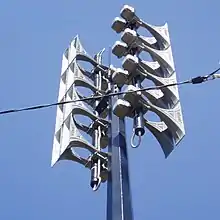

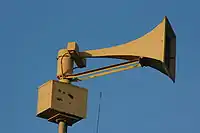
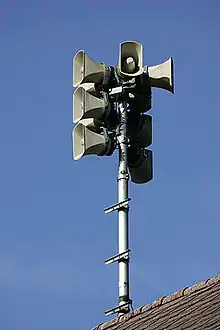
A mechanical siren generates sound by spinning a slotted chopper wheel to interrupt a stream of air at a regular rate. Modern sirens can develop a sound level of up to 135 decibels at 100 feet (30 m). The Chrysler air raid siren, driven by a 331-cubic-inch (5.4-liter) Chrysler Hemi gasoline engine, generates 138 dB at 100 feet (30 m).[2]
By use of varying tones or binary patterns of sound, different alert conditions can be signaled. Electronic sirens can transmit voice announcements in addition to alert tone signals. Siren systems may be electronically controlled and integrated into other warning systems.
Sirens in integrated public warning systems

Sirens are sometimes integrated into a warning system that links sirens with other warning media, such as the radio and TV Emergency Alert System, NOAA Weather Radio, telephone alerting systems, Reverse 911, Cable Override, and wireless alerting systems in the United States and the National Public Alerting System, Alert Ready, in Canada. This fluid approach enhances the credibility of warnings and reduces the risk of assumed false alarms by corroborating warning messages through multiple forms of media. The Common Alerting Protocol is a technical standard for this sort of multi-system integration.[3]
Siren installations have many ways of being activated. Commonly used methods are dual-tone multi-frequency signaling (DTMF) or public switched telephone network (PSTN) using telephone lines, but activation can also be done via radio broadcast. This method opens up vulnerability for exploitation, but there are protections from false alarms. These sirens can also be tied into other networks such as a fire department's volunteer notification/paging system. The basics of this type of installation would consist of a device (possibly the same pager the firefighters have) connected to the controller/timer system of the siren. When a page is received, the siren is activated.
Types of sirens
Mechanical sirens

A mechanical siren uses a rotor and stator to chop an air stream, which is forced through the siren by radial vanes in the spinning rotor. An example of this type of siren is the Federal Signal 2T22, which was originally developed during the Cold War and produced from the early 1950s to the late 1980s. This particular design employs dual rotors and stators to sound each pitch. Because the sound power output of this type of siren is the same in every direction at all times, it is described as omnidirectional. The Federal 2T22 was also marketed in a 3-signal configuration known as the Federal Signal 3T22, with the capability for a "hi-lo" signal. Some sirens, like the Federal Signal Thunderbolt series, had a blower so that more air could be pumped into the siren.
While some mechanical sirens produce sound in all directions simultaneously, other designs produce sound in only one direction, while employing a rotator mechanism to turn the siren head through 360 degrees of rotation. One rare type of mechanical siren, the Federal Signal RSH-10 ("Thunderbeam"), does not rotate or produce equal sound output in all directions. It instead uses a slowly rotating angled disc below the siren which directs the siren's output throughout 360 degrees.[4] The chopper of this siren is taken from another one of Federal Signal's sirens, the STH-10.
The Federal Signal Thunderbolt series creates its sound by using a separate blower to force air through the rotor. Horns with an exponential profile then amplify the sound. Within the Thunderbolt product line, three different configurations were offered: the Thunderbolt 1000, a single-tone siren; the Thunderbolt 1000T, a dual-tone siren; and the Thunderbolt 1003, a variation of the 1000T that employs solenoid-actuated slide valves to create a "hi-lo" signal primarily used as a fire signal. Another example of a siren that has a separate blower is the Alerting Communicators of America (ACA) Hurricane.
A variation on the electromechanical siren is the pneumatic hochleistungssirene (HLS), first produced by the German firm Pintsch-Bamag and later by the German firm Hörmann. Soon afterward, Hörmann improved on the design to create the HLS 273, which did away with the massive siren head of the original in favor of a more compact head and cast aluminum exponential-profile horns. These sirens stored a reservoir of compressed air, recharged periodically by a diesel engine-driven compressor in a vault in the base of the massive siren unit. The later HLS 273 placed the large (6,000 liter) air tank underground beside the machinery vault, instead of in the mast itself as in the earlier HLS units.
Electronic sirens
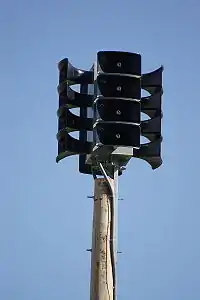
Electronic sirens consist of an electronic tone generator, a high-power amplifier, and a horn loudspeaker. Typically, the loudspeaker unit incorporates horn loading, causing them to be similar in appearance to some electromechanical sirens. Many of these loudspeakers incorporate a vertical array of horns to achieve pattern control in the vertical plane. Each cell of the loudspeaker horn is driven by one or more compression drivers. One type of compression driver for this type of loudspeaker handles 400 watts of electrical power and uses two doughnut-shaped permanent magnet slugs to provide magnetic flux. For siren applications, high-fidelity sound is a secondary concern to high output, and siren drivers typically produce large amounts of distortion which would not be tolerable in an audio system where fidelity is important.
As with electromechanical sirens, there are both omnidirectional and rotating categories, though Whelen Engineering produces sirens which oscillate through 360 degrees, rotating in one direction and then in the other to allow a hard-wired connection between the amplifiers and the siren drivers. These sirens can also be set to rotate any amount from 0 to 360 degrees, allowing sirens to broadcast only in certain directions.
Examples of rotating electronic siren are the Whelen Engineering Vortex, American Signal Alertronic RE1600, and Federal Signal SiraTone 408, 612, and 812 (these designs incorporate four vertically arrayed loudspeaker cells exiting into a common manifold). This horn design accomplishes pattern control in the vertical plane and focuses the output into a high-penetration beam. Examples of omnidirectional electronic sirens are the Federal Signal EOWS1212, Federal Signal Modulator series, HSS Engineering A/S, Whelen Engineering WPS2700, WPS2800, and WPS2900, ATI HPSS, and American Signal I-Force, in which compression drivers located in each cell exit into the center of the cell. The contour of each cell forms the horn.
Civil defense sirens around the world

Saudi Arabia
The purpose of warnings is to notify the population of a danger that threatens their lives. Individuals must go to shelters or their homes, lock doors and windows, take appropriate protective actions, and listen through the radio and television for instructions of civil defense.[5]
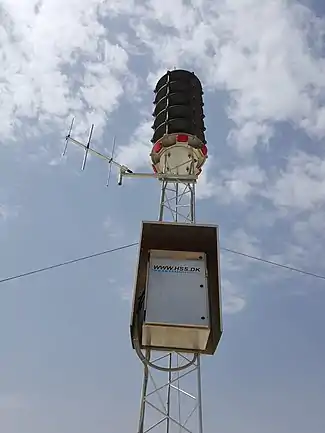
The People's Republic of China
China has sirens located in most cities and towns, particularly those located in or near disputed territories. If the state declares a state of emergency due to attacks or invasion, or when there is a very high risk of military conflict, sirens will warn the public of possible attacks or invasion. The sirens are controlled by the People's Liberation Army.
There are annual or semi-annual test runs, often occurring on commemorative dates that are associated with the Second Sino-Japanese War. For example, Nanjing annually tests air raid sirens at 10 a.m. on 13 December, followed by a moment of silence to commemorate the Nanking Massacre. There have also been some commemorative tests during the memorial periods of major disasters, such as on 19 May 2008 in memory of victims of the 2008 Sichuan Earthquake.
The air raid warning comes in 3 types:[6]
- Pre-raid warning: a 36-second high-tone followed by a 24-second low-tone, with three cycles per period. This warning signifies an air raid is likely about to take place.
- Raid warning: a 6-second high-tone followed by a 6-second low tone, with 15 cycles per period. This signifies that an air raid is imminent.
- Post-raid warning: a single 3-minute high-tone. When sounded, it signifies an end to the raid or a cool-down of the wartime situation.
Taiwan

Taiwanese civil defense sirens are erected on police stations, and commanded by the nation's Civil Defense Office (民防指揮管制所). The government issues air raid warnings, as well as tsunami warnings, through the sirens in conjunction with their own Public Warning System that utilizes 4G LTE cell signals. The Taiwanese government also holds annual air-raid drills called Wan-an drills (萬安演習) so the populace can be familiar with what to do in an air raid, given the high risk of war with its neighboring country, China.
India
Mumbai has around 200–250 functional sirens. The government is planning to change the system by incorporating modern wireless and digital technology in place of the present landline switching system.
In Mumbai civil defence, sirens were used during the Indo-Pakistan wars of 1965 and 1971, warning civilians about air raids by the Pakistan Air Force. At night, sirens were also used to indicate blackouts, when all lights in Mumbai were switched off. Daily tests of the sirens at 9 a.m. were recently reduced to once per month. They are controlled by the Regional Civil Defence Control Center, Mumbai, with input from Indian Defence Services. Sirens are also used to denote a minute's worth of silence on special occasions.[7]
Israel
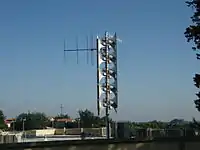
Israel has more than 3,100 warning sirens. Most of the sirens in urban areas are German-made HLS sirens, models F71 and ECN3000. All the other sirens are HPSS32 models made by Acoustic Technologies (ATI). During the early 2010s, mechanical sirens were gradually phased out and replaced by electronic ones, although the mechanical ones were generally left standing. The air-raid sirens are called אזעקה (az'aka 'alarm'), and consist of a continuous ascending and descending tone. The "all clear" signal, called צפירת הרגעה (tzfirat harga'a), is a constant single-pitch sound. In recent conflicts, use of the "all clear" signal has been discontinued, as it was seen as causing unnecessary confusion and alarm. In certain regions in the south of Israel, which regularly undergo rocket attacks from Gaza, a specialized system called Red Color is used.
The "all clear" signal is used three times per year to denote a moment of silence (of one or two minutes): once on Israel's Holocaust Remembrance Day and twice on the Day of Remembrance.
Singapore
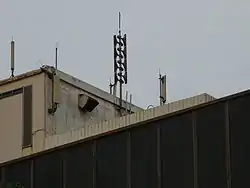
Singapore currently has a network of 284 stationary sirens named the Public Warning System which warns the entire country of air raids, as well as human-made and natural disasters (except earth tremors). Singapore's sirens are tested at noon on the first day of every month. During the test, the sirens sound a light cheerful chime instead of any of the three signals. The sirens look very similar to the ECN3000 Israel version.
South Korea
Nearly all towns and cities are equipped with civil defense sirens in case of natural disasters or missile attacks from North Korea. South Korea holds civil defense drills every month to prepare for such scenarios.[8]
Austria
Austria is fully covered with an operational air-raid siren system consisting of 8,203 devices as of 2012. They are tested weekly at noon on Saturdays (except in Vienna) with the sirenenprobe signal, a 15-second continuous tone. Every year on the first Saturday of October, the whole range of alarm signals (with the exception of the fire alert) is sounded as a system test (Zivilschutz-Probealarm) and to familiarize the population with the signals.
- Warning: a 3-minute continuous tone. People are warned of an incoming danger and advised to tune into the appropriate Ö2 regional radio station or ORF 2[9] for further instructions.
- General alarm: a 1-minute ascending and descending tone. Danger is imminent; people should seek shelter immediately and listen to radio or TV.
- End of danger: a 1-minute continuous tone. The danger is over, and shelters can be left. Any hazards potentially encountered during normal life are announced in the media.
- Fire alert: three 15-second continuous tones separated by 7-second intervals. All firemen of volunteer fire brigades should report to their fire station immediately. This signal is being used less and less, as many fire brigades have begun to alert their members by radio.
Belgium
Belgium used to test its air raid sirens every first Thursday of the trimester (three-month period). Sirens are Sonnenburg Electronic sirens. When the air-raid sirens are tested, the message "proefsignaal" or "signal d'essai" is broadcast every time the sirens sound. There are 540 sirens all across the country.[10] A non-audible test was performed every day, and the last test occurred on 4 October 2018.[11] Afterwards, the network was decommissioned. The sirens remain around nuclear facilities, but no tests are performed.[12] The official recommendation is that people subscribe to BE-Alert,[13] a system where information is provided via SMS, e-mail or phone.[14]
Czech Republic
The Czech Republic has around 6,000 sirens. They are tested every first Wednesday of the month. There are three warning signals, which are accompanied by a verbal message in Czech and usually with an English and German translation on electronic sirens. There is also an emergency broadcast on TV channels, maintained by Česká televize, and radio channels, maintained by Český rozhlas.
- General alert: a 140 second long fluctuating tone. The alert can be repeated up to 3 times in 3-minute intervals, and has 4 possible verbal messages:
- "Všeobecná výstraha, všeobecná výstraha, všeobecná výstraha. Sledujte vysílání Českého rozhlasu, televize a regionálních rozhlasů. Všeobecná výstraha, všeobecná výstraha, všeobecná výstraha." The danger is unspecified and people should go inside a building, close the doors and windows (the alert usually means a dangerous element may be present in the air), and turn the TV or radio to an appropriate channel to find out more.
- "Nebezpečí zátopové vlny, nebezpečí zátopové vlny. Ohrožení zátopovou vlnou. Sledujte vysílání Českého rozhlasu, televize a regionálních rozhlasů. Nebezpečí zátopové vlny, nebezpečí zátopové vlny." A flooding alert. People should turn on the radio and get away from the source of danger (usually a river).
- "Chemická havárie, chemická havárie, chemická havárie. Ohrožení únikem škodlivin. Sledujte vysílání Českého rozhlasu, televize a regionálních rozhlasů. Chemická havárie, chemická havárie, chemická havárie." There was a chemical accident. People should behave the same way as during an Obecná výstraha message.
- "Radiační havárie, radiační havárie, radiační havárie. Ohrožení únikem radioaktivních látek. Sledujte vysílání Českého rozhlasu, televize a regionálních rozhlasů. Radiační havárie, radiační havárie, radiační havárie." There was a radioactive accident. People should behave the same way as during an Obecná výstraha message.
- Testing of sirens: a 140 seconds long still tone, used to test the functionality of the sirens. "Zkouška sirén, zkouška sirén, zkouška sirén. Za několik minut proběhne zkouška sirén. Zkouška sirén, zkouška sirén, zkouška sirén." is the verbal message before the test, and "Zkouška sirén, zkouška sirén, zkouška sirén. Právě proběhla zkouška sirén. Zkouška sirén, zkouška sirén, zkouška sirén." is the verbal message after the test.
- Fire alert: a 60 second long still tone with a pause. It is used to alert firefighters of a fire, accompanied by this verbal message: "Požární poplach, požární poplach, požární poplach. Svolání hasičů, svolání hasičů. Byl vyhlášen požární poplach. Požární poplach."
- All clear: There is no all clear signal, only a verbal message: "Konec poplachu, konec poplachu, konec poplachu. Sledujte vysílání Českého rozhlasu, televize a regionálních rozhlasů. Konec poplachu, konec poplachu, konec poplachu."
Denmark
1,078 electronic warning sirens have been installed in Denmark by HSS Engineering. The sirens are placed on the tops of buildings or on masts. This warning system makes it possible to warn the populations of all urban areas with more than 1,000 inhabitants. This means that about 80% of Denmark's population can be warned using stationary sirens. The remaining 20% are warned by mobile sirens mounted on police cars. The function of the sirens is tested every night, but does not produce any sound. Once every year, on the first Wednesday of May at 12:00, the sirens are tested with sound.[15]
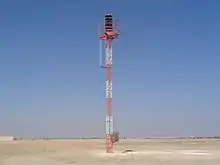
Finland
A general alarm consists of a repeating 1-minute sound, made up of tones that ascend for 7 seconds and descend for 7 seconds. The end of danger is signaled by a 1-minute continuous tone. Warning sirens are tested on the first Monday of every month at noon. The testing alarm is shorter than the general alarm (only lasting for 7 or 14 seconds) and may be a flat tone.[16]
France
In France, the emergency population warning network is called the "Réseau national d'alerte" (RNA). The system is inherited from the air raid siren network (défense passive) developed before World War II. It consists of about 4,500 electronic or electromechanical sirens placed all over France.[17] The system is tested each month at noon on the first Wednesday. The most common siren type is the electromechanical KM Europ 8 port single tone siren. These sirens have a very characteristic sound: a very fast wind-up and a lower pitch than most sirens (the pitch is comparable to a STL-10 on a lower frequency resulting on a lower pitch). A recording of these sirens was used in the movie Silent Hill.
Germany
In Germany, the Warnämter ('warning authorities') were closed in the 1990s after the threat of the Cold War was over, since the ability to alert the public was then considered unnecessary. As the civil defense sirens were also frequently used to alert volunteer firefighters, many sirens were sold to municipalities for a symbolic price; others were dismantled. In the 2000s, it was realized that the ability to warn the public is not only necessary in cases of war, but also in events like natural disasters, chemical or nuclear accidents, or terrorist attacks. As a result, some cities like Düsseldorf and Dresden began to rebuild their warning sirens. In Hamburg, the sirens are still operational. They also warn the public during storm surges; for instance, all towns in the Moselle Valley continue to operate and test their warning sirens. The majority of operational sirens in Germany are either electric-mechanical type E57 or electronic sirens.
During World War II, Berlin's air raid sirens became known by the city's residents as "Meier's trumpets" or "Meier's hunting horns" due to Luftwaffe chief Hermann Goering's boast that "If a single bomb ever falls on Berlin, you can call me Meier!".[18]
Italy
The Italian War Ministry began installing air raid sirens and issuing air defence regulations in 1938. Production was entrusted to La Sonora, founded in 1911 and still active today.[19]
During World War II, every town had a siren, and several were present in each large city. Even after the danger of bombings had ended, they were kept to provide warning in case of any threat (e.g. high water in Venice).
As of 2015, some of them still survive. For instance, as many as 34 have been located in Rome using crowdsourcing. Up until the 1980s, they underwent routine maintenance and sounded at noon.[20]
Additionally, the Protezione Civile (Civil Protection) operates sirens to warn the public in case of a threat to the citizen population. Protezione Civile also provides transport needs and military defence for the Government of Italy. These defence systems were put in place in the 1990s and are occasionally still used today.[21]
Netherlands
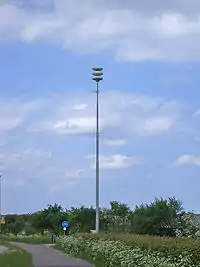
The Netherlands tests its air-raid sirens once per month, on the first Monday at noon, to keep the public aware of the system. There are about 4,200 sirens placed all across the country.[22] In March 2015 it was announced that, due to high maintenance costs, the sirens will be taken out of service by the end of 2020.[23] The government has implemented a Cell Broadcast system called NL-Alert, compliant to the mandatory European regulation EU-Alert, to replace the sirens by 2021. However, as of late 2019, the sirens will continue to be heard until another decision has been made.[24]
Norway
Norway has about 1,250 operational sirens (mostly Kockums air horn units rather than motorized sirens), primarily located in cities. Three different signals are used:
- Critical message, listen to radio: three periods of three signals, separated by one minute between the periods. The "critical message" signal is followed by a radio broadcast. It is used in peacetime to warn the population about major accidents, large fires and gas leaks.[25]
- Air raid, take cover: an intermittent signal lasting for about a minute.
- All clear: a continuous signal sounded for about 30 seconds.
The sirens are tested twice each year, at noon on the second Wednesday of January and June. As of 2014, only the '"critical message" signal is used during tests. Previously, the signal tested in June would use the "air raid" and "all clear" signals. The latter two are no longer used in peacetime.
There are also sirens in the Storfjord area in Møre og Romsdal county to warn about an avalanche from the mountain Åkerneset. These sirens are not operated by Norwegian Civil Defense department; instead, they are operated by Åksnes/Tafjord Beredskap. These sirens can be found in the villages of Stranda, Tafjord, Geiranger, Hellesylt, Linge and Valldal.
Romania
In Romania, civil defense sirens have been used since the early 1930s. Originally, each street had a small siren on top of a high-rise building, which could be powered mechanically. During World War II, the sirens had a single continuous tone to warn of an air strike.[26]
Throughout the Cold War, larger sirens were manufactured locally and installed on various public buildings and residences.[27] The sirens were able to transmit a comprehensive variety of tones, each with a different meaning such as a chemical disaster, an earthquake, a flood, or an imminent air or nuclear strike; each of these tones required the population to either move to higher ground or an ABC shelter. An "all clear" signal was played after the area had been deemed safe for the general public.
Since the 1990s, civil defense sirens have been replaced by electronic sirens and the procedure has been simplified. As of 2013, there are four playable tones: a natural disaster warning, an upcoming air/nuclear strike, an imminent air/nuclear strike, and an "all clear" signal. Taking shelter is no longer a legal requirement, although ABC shelters are still operational.[28]
In August 2017, Romanian authorities started to perform monthly defence siren tests. The first such test took place on 2 August 2017 and is scheduled to be repeated on the first Wednesday of each month, between 10:00 and 11:00 am local time. Such tests have been stopped in the wake of the COVID-19 pandemic.[29]
Russia
During the siege of Leningrad, the radio network carried information for the population about raids and air alerts. The famous "metronome" went down in the history of the siege of Leningrad as a cultural monument of resistance of the population[3]
At that time , there were more than 1 thousand loudspeakers and 400 thousand radio streams operating in the city. If there were no broadcast programs, then the metronome was broadcast with a slow rhythm of 50-55 beats per minute. The network was switched on around the clock, which allowed the population and services to be confident in the operation of the network. By order of the MPVO headquarters, the duty officer of the Central station of the radio network interrupted the broadcast of the program, turned on an electric player with a record of the alarm text. This record was supplemented by 400 electric sirens. At the end of the recording, the metronome was switched on with a rapid rhythm of 160-180 beats per minute. When the danger was over, the electric player was switched on again by order of the staff , and the alarm was sounded in the streets and houses, accompanied by the sound of fanfares
Slovenia
Slovenia has 1,496 operable civil defence sirens.[30] Most of them are electronic sirens, although there are some mechanical ones. Civil defence sirens are mounted on fire stations, town halls, or other structures.
Three siren tones are used in the country:[31]
- Warning: a 2 minute long steady tone. Used to warn of the impending danger of a fire, environmental or other disaster, or high water level.
- Immediate danger: a 1 minute wailing tone. Used to warn of the danger of a major fire, flood, radiological or chemical danger, or air raid.
- All clear: a 30-second steady tone. Sounded during tests of the sirens the first Saturday of each month at noon, and at the end of an emergency for which the immediate danger signal was sounded.
The municipalities of Brežice, Krško, Sevnica, Hrastnik, and Trbovlje use a special signal for the immediate danger of an accident involving chlorine when there is a danger of chlorine leaks in the environment. The 100 second long signal consists of a 30-second wailing tone, a 40-second steady tone, and a second 30-second wailing tone. The municipalities of Muta, Vuzenica, Podvelka, Ribnica na Pohorju and Radlje ob Dravi use a 100-second signal (consisting of a 4-second wail followed by 4 seconds of silence) for the immediate danger of flash floods, used in the event of overflow or collapse of a hydroelectric dam.[31]
When emergencies impact two or more regions at the same time, or the whole country, people are advised to listen to the first channel of Radio Slovenia, Val 202, or watch TV Slovenia 1/TV Slovenia 2. Emergencies of a smaller extent are announced via regional radio and TV stations.[32]
Spain
Few sirens that were used for civil defence against bombings during the Spanish Civil War are preserved. The Guernica siren has a highly symbolic value because of the impact of the Bombing of Guernica. Barcelona City History Museum preserves one related to the Bombing of Barcelona, and another siren from civil war years is also preserved in Valencia.
Sweden
The Swedish alarm system uses outdoor sirens in addition to information transmitted through radio and television. Special radio receivers are handed out to residents living near nuclear power plants. The outdoor system Viktigt meddelande till allmänheten, also known as Hesa Fredrik ('Hoarse Fredrik', alluding to the sound of the siren) to the Swedish population, consists of 4,600 sirens. These sirens were first tested in 1931, and were mounted to cars and bikes sent out by the government. The sirens can be found on tall buildings all around Sweden. They are driven by compressed air in giant tanks, but are successively being replaced by modern electronic sirens which use speakers. The emergency services are also able to send out spoken messages through the new sirens. The outdoor signals used are as follows:
- Readiness alarm (Beredskapslarm): a 5-minute pattern of 30 second tones separated by 15 second gaps. Used when an imminent danger of war is present.
- Air raid alarm (Flyglarm): a 1-minute pattern of 2 second tones separated by 2 second gaps. Sent when the threat of an air attack is imminent.
- Important public announcement, general alarm (Viktigt meddelande till allmänheten): a pattern of 7 second long tones and 14 second long gaps. People should go inside, close windows and doors, close ventilation, and listen to radio channel P4.
- All clear (Faran över): a 30-second long single tone. Used for all above signals when danger is over.
The outdoor sirens are tested four times a year on the first non-holiday Monday of March, June, September, and December at 15:00 local time. The test consists of the general alarm for 2 minutes, followed by a 90-second gap before the "all clear" is sounded.
There are usually around 15 to 20 general alarms per year. The most common cause of general alarms is fire, specially in situations that involve industries, landfills, and other facilities containing dangerous substances which can create hazardous smoke. The 2018 peak in alarms (54 that year) is attributed to the 2018 Sweden wildfires which alone caused over 20 general alarms. Other possible attributing factors could be the increased public safety awareness after the 2017 Stockholm truck attack.[33]
![]() Audio sample of signal "Important public announcement" recorded in Stockholm, 6 March 2017
Audio sample of signal "Important public announcement" recorded in Stockholm, 6 March 2017
Switzerland

Switzerland currently has 8,500 mobile and stationary civil defense sirens, which can alert 99% of the population.[34] There are also 700 sirens located near dams.[34] Every year on the first Wednesday of February, Switzerland's sirens are tested to see if they are functioning properly. During this test, general alert sirens as well as sirens near dams are checked.[34] The population is informed of the test in the days leading up to the tests by radio, television, teletext, and newspapers, and the siren tests do not require the population to take any special measures.[34]
The tones of the different sirens are provided on the last page of all phone books as well as on the Internet.
- General alert: a 1-minute regularly ascending and descending tone, followed by a 2-minute interval of silence before repeating. The 'general alert' siren goes off when there is a possible threat to the population. The population is instructed to inform those around them to proceed inside. Once inside, people are instructed to listen to emergency broadcasts made by the broadcasting networks SRF, RTS, RSI and RSR.[34]
- Flood alert: 12 continuous low-pitched tones, each lasting 20 seconds. The flood alert is activated once the general siren is sounding. If heard by the population in danger zones (such as near dams), they must leave the dangerous area immediately or find shelter.[34]
United Kingdom

During World War II, Britain had two warning tones:
- Red warning: attack in progress or imminent
- All clear: attack over
These tones would be initiated by the Royal Observer Corps after spotting Luftwaffe aircraft coming toward Britain, with the help of coastal radar stations. The "red warning" would be sounded when the Royal Observer Corps spotted enemy aircraft in the immediate area. The sirens were tested periodically by emitting the tones in reverse order, with the "all clear" tone followed by the "red warning" tone. This ensured the public would not confuse a test with a real warning.
Every village, town, and city in the United Kingdom used to have a network of dual-tone sirens to warn of incoming air raids during World War II. The operation of the sirens was coordinated by a wire broadcast system via police stations. In towns and cities with a population of over 3,000, powered sirens were used, whereas in rural areas hand-operated sirens were used (which were later put to use as warnings for nuclear attack during the Cold War). At the end of the Cold War in 1992, the siren network was decommissioned, and very few remain.[35] These sirens, mostly built by Carter, Gents, Castle Castings, and Secomak (now Klaxon Signal Co.), have 10 and 12 ports to create a minor third interval (B♭ and D♭ notes) and are probably the world's most recognised World War II air raid siren sound. Recordings of British sirens are often dubbed into movies set in countries which never used this type of siren.
Around 1,200 sirens remain, mostly used to warn the public of severe flooding. They are also used for public warning near gas or nuclear power plants, nuclear submarine bases, oil refineries and chemical plants. The remaining sirens are a mix of older motor driven models (usually from World War II), such as the Carter siren manufactured by Carter's of Nelson or the "syren" manufactured by Gent's of Leicester, and Cold War and newer electronic sirens. They are tested annually between August and September.
With the advent of digital services and mobile technology, many local authorities are now retiring their siren networks in favour of contacting people by telephone. In January 2007, proposals to retire a network of sirens in Norfolk were made by the Norfolk Resilience Forum. In November 2007, residents were angered after the sirens had not sounded following a tidal surge in Walcott. In 2008, a review of the current and future role of flood warning sirens was undertaken by Norfolk County Council, after plans to retire them were halted following concerns from nearby residents.[36] Although some of the sirens were initially withdrawn, 40 out of the 57 were eventually temporarily reinstated.[37] Despite this, in July 2010 the flood warning sirens were finally retired in favour of alerting people by telephone, SMS or e-mail. After three years of consultations, the council had failed to demonstrate that refurbishing the sirens would be a worthwhile investment.[38]
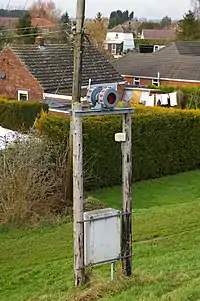
Lincolnshire, which had one of the largest siren systems in the country,[39] had 46 sirens based in North Somercotes, Mablethorpe, Boston, Skegness, Spalding and Sutton Bridge, as well as inland at Louth, Horncastle, Middle Rasen and Gainsborough, the areas most at risk of being hit by floods.[40][41] Following serious flooding in the summer of 2007, investigations took place into how the flood warning system could be improved. The Environment Agency admitted that the warning system in Louth had not sounded early enough.[42] In April 2008, Lincolnshire County Council began to investigate the possibility of replacing the flood warning sirens with mobile phone alerts.[43] A council report in November 2009 described the sirens as being "outdated, in the wrong places and difficult to repair".[44] The sirens were eventually decommissioned in November 2011 and replaced with Floodline.[45]
In January 2010, 13 public warning sirens on the island of Guernsey that had first been installed in 1937 were due to be retired and replaced by text messages. This followed claims by the Home Department that the sirens had "reached the end of their useful working life". The sirens had previously been used to warn of major incidents.[46] From 1950 to 2010, the Civil Defence Committee took responsibility for the sirens, and had tested them annually since 9 May 1979.[47] Members of the public had criticised the decision,[35] and Deputy Janine Le Sauvage claimed that sirens were the only way everyone knew there was an emergency.[48] In February 2010, 40 islanders formed a protest march opposing the proposal to retire the sirens.[49] The campaigners accused the government of not listening to them, as an online petition calling for the sirens to be saved was signed by more than 2,000 people.[50] In April 2010, it was decided to dismantle the public warning system.[51] Emergency planners had proposed to use a new warning system that would contact residents by telephone; however, this was abandoned due to technical limitations and local media and other communication methods are used instead.[52]
Following severe flooding in Upper Calder Valley in June 2000, the Environment Agency replaced its network of sirens, with eight being placed around Walsden, Todmorden, Hebden Bridge and Mytholmroyd. The network was designed to complement the agency's Floodline service.[53]
In November 2010, 36 flood warning sirens in Essex, including nine on Canvey, were retired following concerns from the county council that the system was "no longer fit for purpose".[54] The sirens were due to become obsolete in 2014.[55]
In September 2012, new flood warning sirens were installed in the Dunhills Estate in Leeds, as part of flood defence work at Wyke Beck.[56] In January 2014, flood sirens sounded for the first time in 30 years on the Isle of Portland.[57]
Broadmoor Hospital uses 13 sirens installed in 1952, which are tested weekly.[58] In July 2014, plans were put forward to retire 7 of the 13 alarms, which had last been properly activated in 1993.[59] The alarms are located in areas such as Sandhurst, Wokingham, Bracknell, Camberley and Bagshot.[60] In June 2016, the West London Mental Health Trust, who manages the hospital, proposed decommissioning the sirens altogether and replacing them with social media alerts through websites such as Twitter.[61]
There are several sirens in use around Avonmouth near Bristol to warn of chemical incidents from industry in the area. These are known as the Severnside Sirens.
Canada
In Canada, a nationwide network of Canadian Line Manufacturing sirens was established in the 1950s to warn urban populations of a possible Soviet nuclear attack. This system was tested nationwide twice in 1961, under the codenames Exercise Tocsin and "Tocsin B". The system was maintained until the 1970s, when advancements in military technology reduced the Soviet nuclear missile strike time from 3–5 hours to less than 15 minutes. Sirens can still be found in many Canadian cities, all in various states of repair. In Toronto, for instance, the network has been abandoned to the point where no level of government will take responsibility for its ownership.[62] A handful of sirens still remain in Toronto in older established neighbourhoods:
- Princess and Bayview Avenue – Bayview Village Park ( REMOVED)
- Dundas Street West and Shaw Street
- York Quay, Harbourfront
Sirens have recently been built within 3 kilometers of the Darlington and Pickering nuclear power plants in the province of Ontario. (Both plants are within 30 kilometers of each other.) These sirens will sound in the event of a nuclear emergency that could result in a release of radioactivity. Sirens have also been placed (and are tested weekly) in Sarnia, Ontario due to the large number of chemical plants in the vicinity.[63][64] These consist mainly of ATI HPSS32 sirens, as well as a Federal Signal Modulator in the rail yards and 3 Thunderbolt 1003s located at the Suncor plant.[65][66] Sirens have also been installed in and around the Grey Bruce Nuclear Generating Station. The sirens are on the plant and in the surrounding communities such as Tiverton, Ontario. One notable siren is a Federal Signal Modulator at the Bruce Nuclear Visitor's Centre. The Public Siren network as it is called, consists of mostly Whelens, Modulators, and Model 2s. One of the sirens in this network (a Model 2) is at Tiverton, which is about 10 km from the plant.
Many warning sirens in Ontario, Manitoba, Saskatchewan and Alberta are now used as tornado warning instruments. Smithers, British Columbia uses an old air raid siren as a noon-day whistle. One of the warning sirens was even used as a goal horn for the Quebec Nordiques between the mid 1980s and 1991. Caledonia, Ontario routinely uses an air raid siren to call in their local volunteer firefighters to the fire hall. NOAA Weather Radios in Canada are often used for advanced warnings about future severe storms whenever people are at home, at a business or in a car.
United States

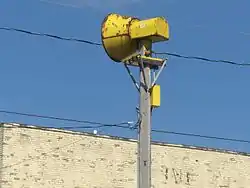
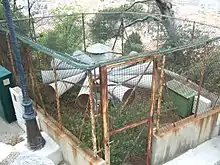
In the United States, several sets of warning tones have been used that have varied due to age, government structure, and manufacturer. The initial alerts used during World War II were the alert signal (a 3–5-minute steady, continuous siren tone) and the attack signal (a 3–5-minute warbling tone, or series of short tone bursts on devices incapable of warbling, such as whistles). The Victory Siren manual stated that when a manual generation of the warbling tone was required, it could be achieved by holding the "Signal" switch on for 8 seconds and off for 4 seconds. In 1950, the Federal Civil Defense Administration revised the signals, naming the alert signal "red alert" and adding an "all clear" signal, characterized by three 1-minute steady blasts with 2 minutes of silence between the blasts.[67]
Beginning in 1952, the Bell and Lights Air Raid Warning System,[68] developed by AT&T, was made available to provide automated transmission of an expanded set of alert signals:
- Red alert: attack imminent
- Yellow alert: attack likely
- White alert: all clear
- Blue alert: undefined
The "yellow alert" and "red alert" signals correspond to the earlier "alert" signal and "attack" signal, respectively, and the early Federal Signal AR timer siren control units featured the "take cover" button labeled with a red background and the "alert" button labeled with a yellow background. Later AF timers changed the color-coding, coloring the "alert" button blue, the "take cover" button yellow, and the "fire" button red (used to call out volunteer firefighters), thus confusing the color-coding of the alerts. In 1955, the Federal Civil Defense Administration again revised the warning signals, altering them to deal with concern over nuclear fallout. The new set of signals were the "alert" signal (unchanged) and the "take cover" signal (previously the "attack" signal). The "all clear" signal was removed because leaving a shelter while fallout was present would prove hazardous.[69]
Sirens began to replace bells for municipal warning in the early 1900s, but became commonplace following America's entry into World War II. Most siren models of this time were single-tone models which often sounded almost an octave higher in pitch than their European counterparts. Dual-tone sirens became more common in the 1950s, but had been used in some areas since about 1915. During the Cold War, standard signals were used throughout the country for civil defense purposes, referred to as "alert" and "attack." Volunteer fire departments generally used a different siren signal. Many towns, especially in California and New England, used coded air horns or diaphones for fire calls and reserved sirens for civil defense use.
Today, signals are determined by state and local authorities, and can vary from one region to another. The most common tones produced by sirens in the United States are "alert" (steady) and "attack" (wail). Other tones include Westminster Chimes (commonly used for the testing of electronic sirens), hi-lo, whoop, pulse, air horn, and fast wail.
The U.S. federal standard regarding emergency warning signals is defined in FEMA's Outdoor Warning Systems Guide, CPG 1-17,[70] published on March 1, 1980, which describes the Civil Defense Warning System (CDWS) and its warning signals. The language was slightly revised by FEMA's National Warning System Operations Manual, Manual 1550.2[71] published 03-30-2001:
- Attack warning: a 3 to 5-minute wavering tone on sirens or a series of short blasts on horns or other devices. The "attack warning" signal means an actual attack or accidental missile launch was detected, and people should take protective action immediately. The signal will be repeated as often as deemed necessary by local government authorities to get the required response from the population, including taking protective action from the arrival of fallout. This signal will have no other meaning and will be used for no other purpose. (However, sometimes the "attack" signals used for tornado warnings.)
- Attention or alert warning: a 3 to 5-minute steady signal from sirens, horns, or other devices. Local government officials may authorize use of this signal to alert the public of peacetime emergencies, normally tornadoes, flash floods, and tsunamis. With the exception of any other meaning or requirement for action as determined by local governments, the "attention" or "alert" signal will indicate that all persons in the United States should "turn on [their] radio or television and listen for essential emergency information".
- A third distinctive signal may be used for other purposes, such as a local fire signal.
- All clear: no all clear signal is defined by either document.
The most common tone, "alert", is widely used by municipalities to warn citizens of impending severe weather, particularly tornadoes. This practice is nearly universal in the Midwest and parts of the Deep South, where intense and fast-moving thunderstorms that can produce tornadoes occur frequently. The "alert" sound is a steady, continuous note. In seaside towns, "alert" may also be used to warn of a tsunami. Sirens that rotate will have a rising-and-falling tone as the direction of the horn changes. The "attack" tone is the rising and falling sound of an air raid or nuclear attack, frequently heard in war movies. It was once reserved for imminent enemy attack, but is today sometimes used to warn of severe weather, tsunamis, or even fire calls, depending on local ordinance.
There is no standard "fire" signal in the United States, and while the use of sirens by volunteer fire departments is still common, it is diminishing. In the dry areas of the American West, residents may be required to shut off outdoor water systems to ensure adequate pressure at fire hydrants upon hearing the signal. The "fire" signal can vary from one community to another. Three long blasts on a siren is one common signal, similar to the signal used by volunteer brigades in Germany and other countries, while other locales use the hi-lo signal described above. Some communities, particularly in New England and northern California, make use of coded blasts over a diaphone or air horn for fire signals, reserving the use of sirens for more serious situations. Still others use the "attack" tone as their fire call. Some communities make use of an "all clear" signal, or sound separate signals for fire calls and ambulance runs. Some fire signals in the U.S. are often blasted at least once a day, mostly at noon, to test the system, and are often referred to as "noon sirens" or "noon whistles".
CPG 1-17 recommends that a monthly test be conducted, consisting of the steady "attention" signal for no more than one minute, one minute of silence, and the "attack" signal for no more than one minute. A "growl test" signal is also described by CPG 1-17, when a siren must be tested more than once a month. This is typically a 1-second burst of sound to verify the proper operation of the siren without causing a significant number of people to interpret the test as an actual alert. Many cities in the U.S. periodically sound their sirens as a test, either weekly, monthly, or yearly, at a day and hour set by each individual city.
In the United States, there is no national level alert system. Normally, sirens are controlled on a county or local level, but some are controlled on a state level, such as in Hawaii. Sirens are usually used to warn of impending natural disaster; while they are also used to warn of threats of military attacks, these rarely occur in the United States. Throughout the Great Plains, Midwest, and South, they are typically used to warn the public to take cover when a tornado warning is issued, sometimes even for severe thunderstorm warnings, and very rarely used for anything else. They are generally required in areas within a ten-mile radius of nuclear power plants. In the South and on the East Coast (except for Texas, Maine, Florida and New Hampshire), sirens are used to inform people about approaching hurricanes.
In Pierce County, Washington there is a system of sirens set up along the Puyallup and Carbon River valleys to warn residents of volcanic eruptions and lahars (giant mudslides) from Mt. Rainier.
Coastal communities, especially those in northern California, Oregon, Washington, Alaska, and Hawaii, use siren systems to warn of incoming tsunamis. In 2011, the city of Honolulu created an "Adopt-A-Siren" website for its tsunami sirens. The site is modeled after Code for America's "Adopt-a-Hydrant", which helps volunteers in Boston sign up to shovel out fire hydrants after storms.[72]
Some U.S. volunteer fire departments, particularly in rural areas, use sirens to call volunteers to assemble at the firehouse. This method is being used less frequently as technology advances. Some areas utilize their sirens as a last resort, relying more on cellular and paging technology; however, a decreasing number of rural brigades are still outside the range of wireless communications and rely on sirens to activate the local volunteer brigade.
Many college campuses in the U.S., especially in the wake of the Virginia Tech shooting, have begun installing sirens to warn students in the event of dangerous incidents. Sirens in the United States have been replaced by NOAA Weather Radios for advanced warnings about future severe storms whenever people are inside cars or buildings.
Australia
A series of 98 electronic sirens, making up a large-scale public-address system (the "Sydney CBD Emergency Warning System") and including 13 variable-message signs, are installed in the Sydney central business district. While installed in the months preceding the 2007 APEC conference, they are designed to be a permanent fixture and are tested on a monthly basis.[73]
Smaller-scale sirens are also deployed, like the Model 5 or Model A, which are used at fire stations for call-outs and at Sydney's beaches for shark alarms. Alarms are also used around prisons for breakouts and at many factories and schools to announce start and finish times.
A siren is located at the Kwinana BP plant south of Perth, which is tested every Monday. It is used to evacuate the plant in case of an emergency and can be heard in Kwinana and certain parts of Rockingham. It can also be used to warn of severe weather and potentially dangerous emergencies on the Kwinana Industrial Strip.
In South Australia, a number of Country Fire Service stations have a mechanical siren on or near the station. These are only activated when the brigade are responding to bushfire or grassfire events and for testing. They are not activated for every call, only as a public alert for the presence of bushfires.
In Victoria, many Country Fire Authority stations have a siren installed that is used to summon volunteers to an emergency callout, as well as consequently alerting the local community of brigade activity. Due to a variety of siren types in use across the state, there are 2 signals that are used, differentiated by length:[74]
- Emergency callout: siren sounds for no longer than 90 seconds.
- Community alert: siren sounds for no shorter than 5 minutes.
In Melbourne's CBD, there is a set of sirens installed to warn of attack and extreme flooding. These became necessary after the Bourke and Flinders St. attacks, where people were killed as a result of a vehicle purposefully driving into pedestrians.
In Queensland, Whelen Vortex 4 sirens have been installed as part of the Somerset Regional Council Flood Warning System. At nearby Grantham, a Whelen WPS2906 which features both warning tones and pre-recorded messages provides early warning in the event of flooding.
New Zealand
Lower Hutt,[75] Napier,[76] Wanganui,[77] and the former Waitakere City area of Auckland[78] each have a network of civil defense sirens. The networks in Lower Hutt and Napier are bolstered by fire sirens that also function as civil defense sirens. Lower Hutt's network is further bolstered by selected industrial sirens that double as civil defence sirens. In the western Bay of Plenty, several fire sirens also serve as civil defense sirens, and there are dedicated civil defense sirens at the Bay Park Raceway in Mount Maunganui, Tokoroa, and Whangamata (which has two). Additionally, Tokoroa, Putaruru, Tirau, and Whangamata have fire sirens serving double duty as civil defense sirens.[79] In the years following the tsunamis of the Indian Ocean earthquake in 2004, Meerkat electronic sirens were installed in all populated areas of the west coast lower than 10 metres.
Warning sounds vary from area to area, including rising and falling notes and Morse code sirens. Communities with volunteer fire brigades use a continuous note on all sirens for civil defense, and a warbling siren on the fire station siren only for fire callouts. Civil defense uses a distinctive "sting" siren that is used by all radio stations nationwide, but is currently only used for civil defense sirens in Wanganui.
References
- Testing sirens Archived 22 October 2013 at the Wayback Machine, Swiss Federal Office for Civil Protection (page visited on 7 September 2013).
- "Air Raid Sirens – Siren Museum". Archived from the original on 19 July 2007. Retrieved 7 July 2007.
- "Common Alerting Protocol | FEMA.gov". www.fema.gov. Retrieved 31 May 2020.
- https://wiki.thesirenboard.com/RSH-10
- "Whistle Alarm". Civil Protection.
- "今天是"9·18"纪念日 教你分辨三种防空警报 河南日报网 - 河南日报官方网站". www.henandaily.cn. Retrieved 5 July 2019.
- "Silent sirens may shriek again under revival plan". DNA India. 25 February 2018. Retrieved 28 April 2019.
- "NY Times: Amid Tension, South Korea Holds Nationwide Air-Raid Drill". Archived from the original on 31 March 2017. Retrieved 24 February 2017.
- "Archived copy". Archived from the original on 22 November 2015. Retrieved 21 November 2015.CS1 maint: archived copy as title (link)
- "Sirenetest in Brussel op 3 April 2014 - Stad Brussel". Archived from the original on 6 October 2012. Retrieved 20 April 2013.
- "Alarmeringstest op 2 april: combinatie sirenes en BE-Alert". Crisiscentrum (in Dutch). 25 March 2015. Retrieved 7 August 2019.
- "Laatste test alarmsirenes op 4 oktober" [Last test of alarm sirens on 4 October]. STORA (in Dutch). 2 October 2018. Retrieved 7 August 2019.
- "4 oktober 2018 - Alarmeringstest" [4 October 2018 - Alarm test]. Crisiscentrum (in Dutch). 2 October 2018. Retrieved 7 August 2019.
- "What is BE-Alert? | BE-Alert". www.be-alert.be. Retrieved 7 August 2019.
- "Denmarks siren warning system, frome DEMA (Danish Emergency Management Agency)". Archived from the original on 22 March 2017. Retrieved 21 March 2017.
- "Toiminta yleisen vaaramerkin soidessa". Archived from the original on 21 July 2018. Retrieved 1 October 2018.
- "Information by the French Government". Archived from the original on 25 October 2007. Retrieved 13 November 2007.
- Dando-Collins, Stephen (2015), Operation Chowhound: The Most Risky, Most Glorious US Bomber Mission of WWII, St. Martin's Press, p. 2, ISBN 978-1-4668-7915-7
- "Archived copy". Archived from the original on 14 July 2015. Retrieved 2 July 2015.CS1 maint: archived copy as title (link)
- "Archived copy". Archived from the original on 3 July 2015. Retrieved 2 July 2015.CS1 maint: archived copy as title (link)
- "Archived copy". Archived from the original on 3 March 2016. Retrieved 12 April 2015.CS1 maint: archived copy as title (link)
- WAS (Waarschuwingsstelsel) Archived 15 February 2009 at the Wayback Machine
- "Archived copy". Archived from the original on 24 September 2015. Retrieved 4 November 2015.CS1 maint: archived copy as title (link)
- https://www.rijksoverheid.nl/actueel/nieuws/2019/11/13/besluit-over-toekomst-sirenes-in-najaar-2020 | archive-date=13 November 2019
- Archived 1 February 2010 at the Wayback Machine Sivilforsvarets varslingssignaler
- Air siren from the Second World War
- "Civil defense in Romania" (PDF). Archived (PDF) from the original on 17 October 2013. Retrieved 12 January 2013.
- "What we need to know about protection signals" (PDF). Archived (PDF) from the original on 13 December 2014. Retrieved 12 January 2013.
- "Ministry of Internal Affairs - IGSU - Press Release 83/August 1, 2017" (PDF). Archived (PDF) from the original on 2 August 2017. Retrieved 2 August 2017.
- "Archived copy". Archived from the original on 24 September 2015. Retrieved 7 August 2015.CS1 maint: archived copy as title (link)
- "Archived copy". Archived from the original on 24 September 2015. Retrieved 7 August 2015.CS1 maint: archived copy as title (link)
- "Archived copy". Archived from the original on 24 December 2015. Retrieved 23 December 2015.CS1 maint: archived copy as title (link)
- Ralstrand, Fredrik (28 December 2018). "Ett rekordår för varningsmeddelanden" [A record year for warning messages]. Trafikredaktionen [the Traffic Department]. Sveriges Radio (in Swedish). Stockholm. Archived from the original on 30 December 2018. Retrieved 30 December 2018.
- (in French) Federal Office for Civil Protection (FOCP) Archived 3 March 2016 at the Wayback Machine – Visited on Wednesday, 10 February 2010
- "Sirens loss 'not a public risk'". 2010. Retrieved 25 October 2017.
- "Flood sirens' future under review". 14 May 2008. Retrieved 23 October 2017.
- "Coastal flood sirens to be saved". 21 May 2008. Retrieved 23 October 2017.
- "Talks over flood warning concerns". 12 May 2010. Retrieved 23 October 2017.
- "Flood siren system to be tested". 12 August 2007. Retrieved 23 October 2017.
- "Testing of county's flood sirens". 30 August 2005. Retrieved 23 October 2017.
- "Rain postpones flood siren test". 12 August 2004. Retrieved 23 October 2017.
- "Flood warning system investigated". 2 October 2007. Retrieved 23 October 2017.
- "Flood siren system under scrutiny". 21 April 2008. Retrieved 23 October 2017.
- "Flood sirens' future considered". 25 November 2009. Retrieved 23 October 2017.
- "Apology over flood siren misery". BBC News. 5 November 2012. Archived from the original on 30 November 2017. Retrieved 23 October 2017.
- "Island's warning sirens removed". 2010. Retrieved 25 October 2017.
- "Sounding the warning since 1937". 2010. Archived from the original on 25 October 2017. Retrieved 25 October 2017.
- "Removing sirens 'may cost lives'". 2010. Retrieved 25 October 2017.
- "Islanders protest over siren plan". 22 February 2010. Retrieved 25 October 2017.
- "States 'not listening' on sirens". 11 February 2010. Retrieved 25 October 2017.
- "Warning sirens to be dismantled". 22 April 2010. Retrieved 25 October 2017.
- "Emergency texts system abandoned". BBC News. 25 March 2013. Archived from the original on 2 December 2017. Retrieved 25 October 2017.
- "Flood warning siren system tested". 23 December 2008. Archived from the original on 14 February 2009. Retrieved 23 October 2017.
- "Flood warning sirens to be axed". BBC News. 4 November 2010. Archived from the original on 30 November 2017. Retrieved 23 October 2017.
- "Island's flood sirens scrapped immediately". Echo. Archived from the original on 23 October 2017. Retrieved 23 October 2017.
- "New flood warning sirens tested". BBC News. 18 September 2012. Archived from the original on 30 November 2017. Retrieved 23 October 2017.
- "Homes evacuated as sirens sound". BBC News. 2014. Archived from the original on 18 February 2019. Retrieved 23 October 2017.
- "The Broadmoor siren". West London Mental Health Trust. Archived from the original on 16 November 2013. Retrieved 14 November 2013.
- "Broadmoor to scrap satellite sirens". BBC News. 11 July 2014. Archived from the original on 30 November 2017. Retrieved 23 October 2017.
- "Twitter 'better' than Broadmoor sirens". BBC News. 14 March 2016. Archived from the original on 30 November 2017. Retrieved 23 October 2017.
- "Broadmoor 'Twitter sirens' need support". BBC News. 2 June 2016. Archived from the original on 30 November 2017. Retrieved 23 October 2017.
- Scrivener, Leslie (23 September 2007). "The mystery of the air raid sirens". The Star. Toronto. Archived from the original on 17 October 2012. Retrieved 30 April 2010.
- "Welcome to the Region of Durham". Archived from the original on 15 February 2009. Retrieved 26 March 2019.
- Community Awareness Emergency Response Archived 7 September 2013 at the Wayback Machine
- "Sarnia, ON Federal Signal Thunderbolt 1003 High Low Fire Signal". YouTube. Retrieved 15 April 2020.
- "Sarnia, Ontario Outdoor Warning Siren Test (ATI)". YouTube. Retrieved 15 April 2020.
- "Civil Defense Museum". Archived from the original on 5 May 2010. Retrieved 22 April 2010.
- "The shawinigan Standard". Archived from the original on 12 March 2016. Retrieved 6 March 2016.
- "5INSTRUC.JPG". Archived from the original on 17 July 2011. Retrieved 22 April 2010.
- "Archived copy" (PDF). Archived (PDF) from the original on 23 September 2015. Retrieved 17 June 2014.CS1 maint: archived copy as title (link)
- "Archived copy" (PDF). Archived (PDF) from the original on 24 September 2015. Retrieved 17 June 2014.CS1 maint: archived copy as title (link)
- Raja, Tasneem (August 2014). "Is Coding the New Literacy?". Mother Jones. Archived from the original on 15 July 2018. Retrieved 21 June 2014.
- "NSW Police Media release - "Police test Sydney CBD Emergency Warning System"". Archived from the original on 15 February 2009. Retrieved 23 December 2008.
- "Community sirens | Emergency Management Victoria". www.emv.vic.gov.au. Archived from the original on 31 March 2016. Retrieved 27 July 2016.
- Hutt City Council Archived 10 December 2014 at the Wayback Machine
- Public Warning Systems - Napier City Council Archived 9 February 2013 at the Wayback Machine
- Wanganui District Council Archived 26 November 2013 at the Wayback Machine
- Civil Defence Emergency Management Archived 29 February 2012 at the Wayback Machine
- Tsunami warning test at Whangamata | Thames-Coromandel District Council Archived 27 September 2011 at the Wayback Machine
External links
- Air Raid Sirens – outdoor warning siren website
- Civil Defense Museum – Overview of sirens since their inception
- Los Angeles air raid sirens – Pictures of unused nuclear-era civil defense sirens still extant in Los Angeles, California
- The Siren Archive – Over 1,000 siren photographs coupled with a few recordings from around the world
- The world's loudest and largest sirens ever
- "Tocsin B", Canada's dry run of its Nuclear Warning System from 1961 (CBC Radio News Special, 13 Nov 1961)
- Toronto Star – The mystery of the air raid sirens
- Michigan Civil Defense Museum
- Old German World War II Air Raid Siren YouTube
- British World War II Air Raid Siren with all-clear YouTube
- Federal Thunderbolt 1000T air raid siren in alert signal YouTube
